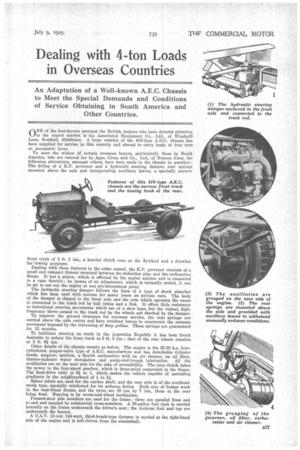Dealing with 4-ton Loads in Overseas Countries
Page 85

If you've noticed an error in this article please click here to report it so we can fix it.
An Adaptation of a Well-known A.E.C. Chassis to Meet the Special Demands and Conditions of Service Obtaining in South America and Other Countries.
ONE of the best-known amongst the British makers who have devoted attention Vito the export market is the Associated Equipment Co., Ltd., of Windmill Lane, Southall, Middlesex. A large number of the 418-type A.E.C. chassis has been supplied for service in this country and abroad to carry loads of four tons on pneumatic tyres.
To meet the wishes of certain overseas buyers, particularly those in South America, who are catered for by Agar, Cross and Co., Ltd., of Buenos Aires, the following alterations, amongst others, have been made to the chassis in question: The fitting of a K.P. governor and a hydraulic steering damper, rear springs mounted above the axle and incorporating auxiliary leaves, a specially narrow front track of 5 ft. 2 ins., a heavier clutch cone on the flywheel and a drawbai for towing purposes.
Dealing with these features in the order named, the K.P. governor consists of a small and compact fitment mounted between the induction pipe and the carburetter flange. It has a piston, which is affected by the engine suction and is connected to a vane throttle ; by means of an adjustment, which is normally sealed, it can be set to cut out the engine at any pre-determined point. The hydraulic steering damper follows the lines of a type of shock absorber which has been used with success for many years on private cars. The body of the damper is clipped to the front axle and the arm which operates the vanes is connected to the track rod by ball joints and a link. It offers little resistance to intentional steering movements which are of a slow type, but the violent, highfrequency blows passed to the track rod by the wheels are checked by the damper. To improve the ground clearance for overseas service, the rear springs are carried above the axle casing and have overload leaves to counteract the extreme movement imposed by the traversing of deep gullies. These springs are guaranteed for 12 months.
To facilitate steering on roads in the Argentine Republic it has been found desirable to reduce the front track to 5 ft. 2 ins.; that of the rear wheels remains at 5 ft. 91 ins.
Other details of the chassis remain as before. The engine is the 35-50 h.p. fourcylindered, poppet-valve type of A.E.C. manufacture an has detachable cylinder heads, magneto ignition, a Zenith carburetter with an air cleaner, an oil filter, thermo-siphonic water circulation and pump-and-trough lubrication. All the auxiliaries are on the near side for the sake of accessibility. The cone clutch takes the power to the four-speed gearbox, which is three-point suspended in the frame. The final-drive ratio is 9* to 1, which makes the vehicle capable of ascending gradients in the neighbourhood of 1 in 31.
Spicer joints are used for the carat' shaft, and the rear axle is of the overheadworm type, specially reinforced for its arduous duties. Both sets of brakes work in the rear-wheel drums, and the tyres are 38 ins. by T ins., those at the rear being dual. Steering is by worm-and-wheel mechanism.
Pressed-steel side members are used for the frame ; these are parallel from end to end and coupled by substantial crass-members. A 35-gallon fuel tank is carried laterally on the frame underneath the driver's seat ; the Autovac feed and tap are underneath the bonnet.
A C.A.V. 12-volt 144-watt, third-brush-type dynamo is carried at the right-hand side of the engine and is belt-driven from the crankshaft.
















































































































































































